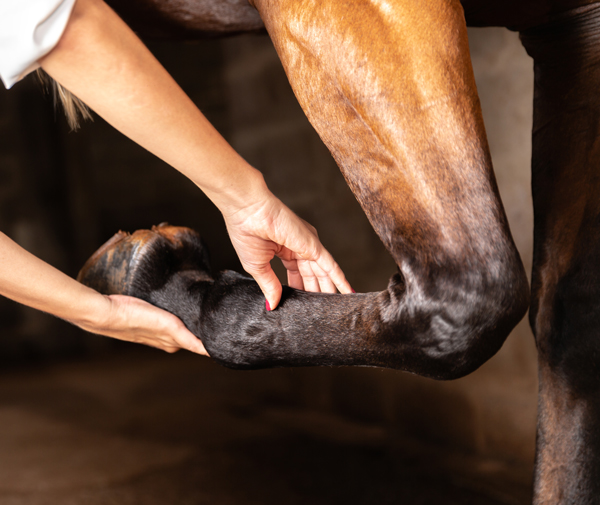
As horse owners we all know how accident and emergency prone horses can be. It’s almost as if they wake up each morning thinking, “How can I get myself into trouble today?” Having the knowledge and skill to handle basic emergencies and to know when to call your veterinarian is vital to your horse’s health.
To be able to recognize an emergency you must first know what normal is for your horse. Know how to obtain your horse’s vital signs and practice taking the heart rate, respiratory rate and temperature when your horse is healthy so you will easily recognize when something is wrong. A good foundation in equine anatomy is also important in handling common injuries. Knowing the names of the body parts can help you better communicate with your veterinarian over the phone and knowledge of the sensitive structures of horses’ limbs (joints, tendons and ligaments) can help you direct therapy.
Horse Handling in an Emergency
Horsemanship skills are something every horse owner practices on a daily basis but handling a horse in an emergency situation for veterinary procedures is a different story. Make sure whoever is holding the horse is comfortable in the position and is able to handle medical procedures (i.e. blood) without losing their composure. Using appropriate restraint for the procedure is also important. This can range from a good hold on the lead rope to a twitch or even sedation. Have the handler stand on the same side of the horse as the person tending to the injury and make sure they are paying attention to where the person is and how the horse is reacting. If the horse begins to act up the handler pull the head towards them, moving the rest of the horse away from the veterinarian, keeping everyone safe.
Bandaging Wounds
While colic (the manifestation of abdominal pain) is the most common emergency we see in horses, lacerations are a very close second. Being able to clean and bandage a wound is imperative for every horse owner. Practice bandaging and ask your veterinarian to watch you place a bandage and give you tips to make them secure and safe. The size and location of the injury will determine if a simple bandage will suffice or if veterinary care is needed. Full thickness cuts may require sutures and any wound near a joint or tendon sheath should be evaluated by a veterinarian, as infection in these areas can be very difficult to treat. Because of the environment horses live in every wound should be considered “contaminated” with dirt and bacteria and require cleaning. Us an antibacterial/antiseptic scrub such as Betatdine or Chlorhexidine. Gently clean the area and rinse thoroughly with clean water. Small wounds can be dressed with an anti-bacterial cream to prevent infection. If the wound is large enough that a veterinarian has been called, do not use any creams or ointments, as they can be difficult to remove before suturing. A non-stick pad should be placed directly on the wound and a light gauze bandage used to hold it in place. A thick padded cotton bandage can then be placed on the limb with an outer layer of self-adhesive bandage (Vetrap) or a reusable polo wrap. Bandages should be changed and the wound evaluated every 24 hours for the first few days. If there is any discharge, swelling or lameness noted, contact your veterinarian.
What To Have On Hand
Having the necessary equipment to deal with emergencies in a handy location you can easily reach is key to helping your horse in his time of need. So what should you have in your first aid kit? What should you pack in the “overhead compartment” of your trailer, tack trunk or saddle bag?
- Your veterinarian’s name and phone number
- Directions to their clinic and major referral hospital
- Address and directions to your location to give to your vet
This information is vital to have. You must be able to contact your veterinarian and give them good information about where you are. If transportation to a referral hospital is needed, having their information handy can save valuable time. - Equine Vitals Sheet and deworming/vaccine history
Information like heart rate, respiratory rate, temperature and an estimate of hydration are things your vet will want to know as they formulate a plan and head out to help you. It’s also important to have information about your horse’s routine care handy so you can give your vet accurate information even when you’re in the heat of the moment. - Thermometer (and a lubricant, such as petroleum jelly)
A quick acting digital thermometer will give you a fast and reliable rectal temperature. Just make sure that you are positioning yourself safely when obtaining this reading. - Antiseptic scrub (betadine or chlorhexidine base)
- Bandage material
Simple bandage material should consist of absorbent non-stick pads, gauze wraps, thicker cotton bandages and an outer wrap. - Antibiotic ointment (water soluble); Furacin, SSD
- Sterile saline eye wash
Problems with they eye is always an emergency and should be seen by a vet ASAP, in the meantime, eyes can be rinsed with any eye wash product that you would put in your own eye. Ointments (especially those that contain Steroids) should not be used unless directed by your veterinarian. - Flashlight/Headlamp
Even in broad daylight there are some parts of the horse that are always in the dark. A good light can help you evaluate the problem. - Scissors
Useful for cutting rope, twine or other things you may become tangled in and can be helpful in making custom fit bandages. - Sharp knife, wire cutters, pliers
In the event that your emergency involves wire or nails. - Stethoscope
For evaluating the heart rate and rhythm and listening for gut sounds. - Dose syringe
Normally used to administer oral medications, they are also useful for irrigating/cleaning wounds. - Tape (white and duct)
There are so many uses for these, we could write an entire chapter just about them! - Latex gloves
Many think these are to keep your hands clean of scrub and creams but they serve the greater purpose of keeping your horse safe from the dirt and bacteria that may be on your hands. - First Aid Handbook
Have a first aid reference book handy to help handle out of the ordinary emergencies.
So when an emergency happens at your barn, take a deep breath and know that you have prepared yourself to handle minor injuries and that your veterinarian is ready to help and only a phone call away.







Great information, Doctor Joan!
Great tips.